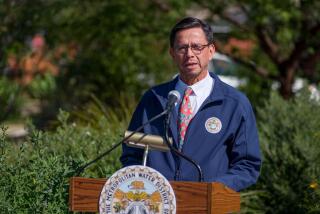Opinion: Is fake grass good for Los Angeles during the drought?
In an effort to convince Angelenos to rip out their water-hogging lawns, the Department of Water and Power has offered one of the most generous grass-removal incentives in the state -- $3 per square foot of lawn replaced by a low-water landscape. The new yard can include drought-tolerant plants, gravel or artificial turf.
I complained recently that some rules in L.A. made it too hard to get rid of the grass and that city leaders should make it as easy as possible for people to install lawn-alternatives, including synthetic turf. I didn’t realize, however, that there is a debate over whether fake grass is good for the environment and whether L.A. should be subsidizing it.
Artificial turf, critics say, shouldn’t be promoted as a grass substitute -- it’s made from petroleum and provides no ecological benefit beyond requiring little water. Some environmentalists even prefer a traditional lawn (provided it’s a low-water variety maintained with an electric mower and without fertilizer) over the fake stuff because at least real grass photosynthesizes and provides habitat for insects and birds.
“The city will be a lifeless and desolate place if parkways are replaced with artificial turf made of fossil fuels or replaced with rocks and gravel in place of a lawn or other living groundcover,” Travis Longcore, science director for the Urban Wildlands Group wrote to the city, opposing an effort to make it easier to install synthetic grass in public parkways.
Lisa Cahill, director of sustainable solutions with the group TreePeople, said fake grass is OK in moderation and may make sense for some homeowners who want a patch of green in their yard. But she doesn’t think the DWP should offer incentives for folks who blanket their property with synthetic turf.
“It almost has the impact of asphalting your front yard,” Cahill said. Artificial turf doesn’t hold rain or surface water like healthy soil does. Los Angeles, which is already covered in pavement, needs more natural terrain to help capture stormwater and reduce the amount of dirty runoff that flows out to the ocean.
Yet, I can understand why the DWP -- and most other water agencies in the state -- offers cash for fake grass. If their focus is on reducing water consumption in the long-term, then artificial grass probably delivers more savings than planting succulents or native plants, which still require some watering.
The DWP largely promotes California friendly landscaping with drought-tolerant plants, but synthetic turf definitely reduces outdoor water use, which is the objective of the Cash for Grass program, said Michelle Figueroa with the DWP.
Nevertheless, the DWP and the city’s Bureau of Sanitation are currently working on a long-term Integrated Resources Plan on how to better capture, recycle and reuse stormwater and wastewater. It’s at least worth debating what role artificial turf plays in the larger goal of making L.A.’s urban environment more sustainable.
For more opinions, follow me @kerrycavan
More to Read
Start your day right
Sign up for Essential California for news, features and recommendations from the L.A. Times and beyond in your inbox six days a week.
You may occasionally receive promotional content from the Los Angeles Times.







